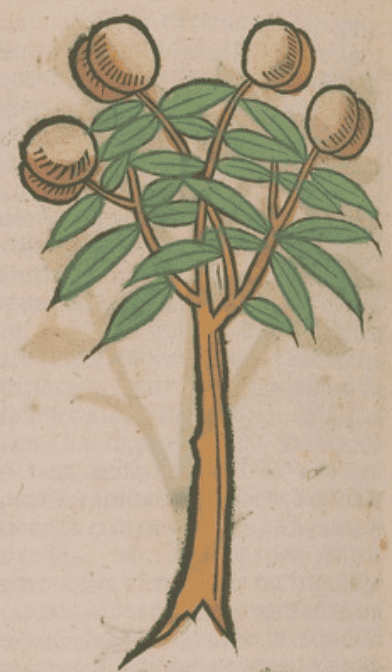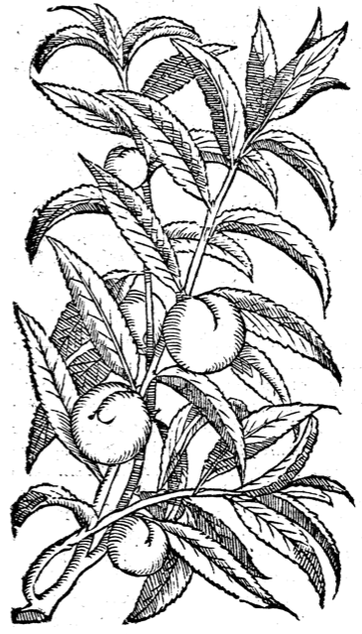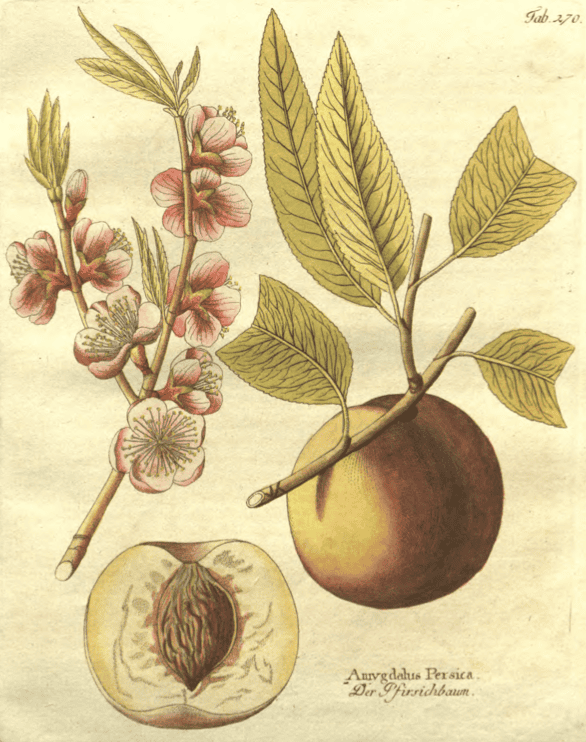Persica, Peach tree, Tao Ren 桃仁Tao Ren (Peach kernel, TCM)Klung kham ཀླུང་ཁམ་ (Tibet) |

|
 Ortus Sanitatis, Meydenbach, 1491
Ortus Sanitatis, Meydenbach, 1491 Dioscorides Materia Medica, Mathias, 1563
Dioscorides Materia Medica, Mathias, 1563 Icones Plantarum Medcio-oeconomico, Vietz, 1806
Icones Plantarum Medcio-oeconomico, Vietz, 1806Botanical name:
Prunus persica
Parts used:
Kernels; Flowers; Leaf; Fruit
The twigs were occasionally used the same as the Leaves in the West.
Temperature & Taste:
Kernel: Neutral in TCM (slightly Warm in the West); Moist. Bitter, Sweet
Leaf, Flower: Warm, dry.
Fruit: Cool, moist
Classifications:
2A APERIENT
3D. CORDIALS & CARDIACS. 3E. DIURETIC. 3F. LITHONTRIPTIC. 3G. EMMENAGOGUE. 3Q. ANTHELMINTIC
4e. STOMACHIC. 4h. NEPHRITIC
Uses:
PEACH KERNEL:
1. Moves the Blood, Clears Stasis (TCM, West):
-menstrual disorders with fixed pain and dark or clotted Blood
-Postpartum Pain
-Tumors, Fibroids, Abdominal masses
-Lung and Intestinal abscess
-Trauma, Bruising
-also for Leukorrhea
2. Promote Urine, Breaks Stones:
-Gravel and Stones (West)
-regarded as very useful for Stones, both to pass and relieve pain
3. Moves the Bowels (TCM, West):
-open Obstruction of the Liver: Jaundice
-used for abdominal pain
-clears Heat of the Stomach
-gentle moist laxative laxative
4. Relieves Cough and Asthma:
-Cough, Wheezing and Asthma (used like Almond)
5. Kills Worms:
-commonly used in Europe to kill and expel Worms
6. Externally:
-externally used in Emulsions against Headaches
-kernels bruised and boiled in vinegar until it is thick, is applied to bald places to promote hair growth. (Culpeper)
-in Tibet to promote growth of hair (oil or decoction topically)
NOTE:
Peach kernel is an important herb to treat Blood Stagnation in TCM. It is also used in TCM as a laxative for Constipation from dryness and weakness. In Europe, it was used for Blood stasis including Apoplexy and Tumors, and was also commonly used for Stones and to Kill Worms.
PEACH LEAF & BARK:
1. Clears Liver Heat:
-Liver congestion; Jaundice; Chronic Hepatitis (Scudder)
-checks vomiting, and stops nausea including morning sickness.
-gentle, mild purgative (esp as a Syrup)
-Stomach, Bowel and Liver conditions associated with heat.
-bark of the Peach tree was said to be the best remedy for Jaundice (Vitalogy)
2. Promotes Urine, Clears Heat and Damp:
-scalding, painful urine
-Hematuria.
3. Clears Phlegm, Stops Cough and Wheezing:
-Cough, chronic Bronchitis, Wheezing, Whooping cough
4. Moves the Blood:
-amenorrhea and abdominal masses and tumors.
-Palpitations.
5. Clears Wind-Heat, Resists Poison:
-Folk Remedy for Fever and Influenza (some commended the infusion)
-the fresh leaves applied to prevent Tetanus (reportedly effective even once lock-jaw begins)
6. Kills worms:
-boiled in milk and taken, or a plaster of the leaves laid to the navel of young children was used to kill Worms
7. Externally:
-used in douches for Uterine prolapse, Vaginal Trichomoniasis
-the leaf and been beaten and applied to Cervical Cancer in TCM.
PEACH TREE FLOWER:
1. Kills Worms:
-Worms in children
2. Moves the Bowels:
-loosen the Belly, opens obstruction of the Mesentery, purges Water
PEACH TREE RESIN:
1. Used for hoarseness, loss of voice, and other defects of the Lungs, including spitting of blood.
2. Considered specific for Stones. (Usually used with Honey)
3. Used as a substitute for Gum Arabic
Dose:
KERNELS: often 15–20 are taken as a dose (for adults)
KERNELS in DECOCTION: 3–6 grams, up to 9 grams (to be taken in 3 equal doses);
LEAF in DECOCTION: 3–6 grams; or half an ounce may be infused in 500 mls of boiling water and taken in Tablespoon doses
BARK in DECOCTION: 3–9 grams
TINCTURE of the BARK (1:5 in 45%): 2–15 drops in water, 2–3 times daily;
PEACH TREE RESIN: 2–6 grams;
Substitute:
1. Bitter Almonds have similar opening, blood-moving effects to Peach kernel, and were also used similarly for Stones. They are regarded as stronger and were more commonly used than Peach kernels in the west.
Main Combinations:
Peach kernel / Bitter Almond kernel & Saffron / Safflower
KERNEL:
1. Usually combined with Safflower (or Saffron) in TCM. Together, these activate the Blood and clear Blood Stasis.
2. Postpartum pain, Peach kernel with Comfrey, Nutmeg and Amber
3. Apoplexy, Loss of Speech, prepare an emulsion of Peach kernels with Pennyroyal water
4. To purge stagnant Blood and Heat (symptoms include headache, vertigo, tinnitus, palpitations, constipation) Peach kernel with Rhubarb, Cinnamon twig and Licorice (as in Tao He Cheng Qi Tang)
5. Amenorrhea, Peach kernel with Dang Gui and Safflower
6. Leukorrhea, Peach kernels tinctured in brandy.
7. Jaundice, beat Peach kernels with vinegar, enough to make it like thin broth. Take this on an empty stomach. (Brunschwig, 1561)
8. Lung Cancer, Peach kernel, Rhubarb, Paeonia Mu Dan Pi
9. Dysuria, Peach kernel, Medlar kernel (equal parts), powder, add sugar (equal to the rest) and take with white wine. (The Secrets of Alexis, 1615)
10. Stones:
i. make an Electuary of Peach kernel with Raisins
ii. take 18 or 20 Peach kernels with quarter ounce of Raisins and drink Pea broth after (Wirtzung)
iii. Urinary stones were treated with Sparganium San Len, Zedoary (E Zhu), Peach kernel (Tao Ren), Paeonia Chi Shao (and others). 100 cases were given the formula every 3 days, 74 were cured, 14 benefited.
11. Worms:
i. Peach kernels, Wormwood
ii. Peach kernels, Pumpkin seed
iii. Peach kernels with Citron seed, Purslane seed and Wormseed
LEAF:
1. Bright’s Disease, Peach leaf with equal parts of Queen of the Meadow (Vitalogy)
2. Uterine prolapse, Peach leaf with Soloman’s Seal, Hops as a douche (Vitalogy)
3. Gastritis, use a fomentation of Peach leaf and Hops made in vinegar and water, while taking an infusion of Peach leaves internally in tablespoonful doses every hour. (Vitalogy).
FLOWER:
1. Worms in Children, Seville Orange seed taken with Syrup of Peach flowers
RESIN:
1. Cough, shortness of Breath, take Peach tree resin a decoction of Coltsfoot.
2. Stones, Peach tree resin with Lemon or Radish juice. (Culpeper)
Major Formulas
Powder for After-pains
Bu Yang Huan Wu Tang
Da Huang Mu Dan Tang
Da Huang Zhe Chong Wan
Di Dang Tang
Gui Zhi Fu Ling Wan
Run Chang Wan
Shen Tong Zhu Yu Tang
Sheng Hua Tang
Tao He Cheng Qi Tang
Tao Hong Si Wu Tang
Xue Fu Zhu Yu Tang
Cautions:
KERNEL:
1. Not used during Pregnancy.
2. Avoid overdose of the kernel; overdose can be fatal.
Toxicity of the Kernel:
7-10 pieces can be fatal to children; 50–60 pieces for adults. This is due to hydrolysis of amygdalin which results in small amounts of hydrocyanic acid which inhibits the respiratory center. Symptoms of overdose include difficulty breathing, spasms, dilated pupils; serious cases may cause coma and death.
Drug Interactions
1. Hydrocyanic acid may potentiate the respiratory depressant effect of Morphine.
Main Preparations used:
Preserved Fruit, Water of the Flowers, Diuretic Water of the Kernels, Syrup of Peach Flowers, Conserve of Peach Flowers, Expressed Oil of Peach Kernels
